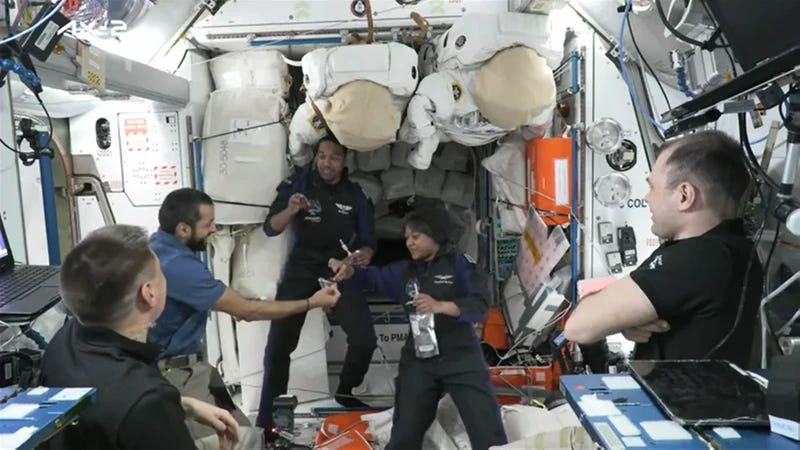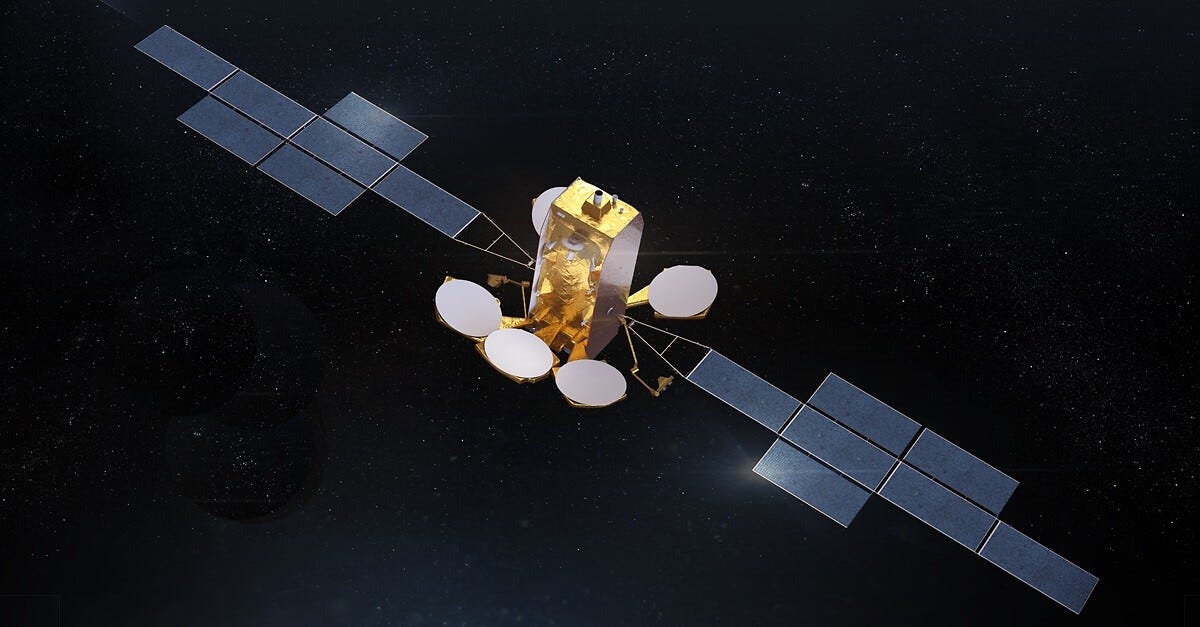Middle East Space Roundup: 21 to 27 May 2023
A summary of all the space news in the Greater Middle East over the past week, powered by AzurX

The following are the major space developments in the Greater Middle East region tracked by Middle East Space Monitor over the past week:
Two Saudi Astronauts Successfully Reach the International Space Station
Axiom Space successfully launched its Ax-2 mission to the International Space Station (ISS) on 21 May 2023. The SpaceX Falcon 9 rocket carrying the Crew Dragon spacecraft lifted off from Kennedy Space Center and the spacecraft docked with the ISS on 22 May 2023. The four-person crew, commanded by Peggy Whitson, includes John Shoffner as the pilot and Saudi Arabia’s astronauts Ali Al Qarni and Rayyanah Barnawi. The mission, initially planned for 10 days, was shortened by two days to accommodate the crowded ISS schedule. The crew will conduct over 20 experiments, including Saudi-developed projects in human physiology, cell biology, and technology. Axiom plans to add commercial modules to the ISS as a precursor to its own standalone space station.
Saudi Space Commission Taps PR Firm Edelman to Handle U.S. Industry Relations
The Saudi Space Commission (SSC) has enlisted the services of public relations consultancy Edelman to help establish relationships with the U.S. space industry, according to Intelligence Online. Edelman, which also represents the Saudi Data and Artificial Intelligence Authority, will assess public opinion, analyse media outlets, and identify journalists who are receptive to the SSC's activities. The SSC aims to collaborate with U.S. and European providers for its Earth-observation satellite constellation programme and the potential development of a military-grade satellite constellation. Edelman has been listed as a donor for the Washington-based think tank Middle East Institute (MEI), which is chaired by former U.S. ambassador to Saudi Arabia John Abizaid. MEI counts private geospatial intelligence (GEOINT) players, including Sierra Nevada Corp., Lockheed Martin, and HawkEye 360, among its sponsors.
UAE’s Thuraya and eSat Global Successfully Complete Satellite IoT Test
UAE’s Thuraya, the mobility arm of Yahsat, and eSAT Global have successfully completed an over-the-air demonstration of a low-latency, direct-to-satellite Internet of Things (IoT) texting system using Thuraya's satellite network. The milestone marks the first achievement resulting from Yahsat's investment in eSAT Global and Thuraya's partnership with the company to develop a next-generation IoT platform. eSAT was able to transmit low-power IoT messages over the Thuraya-2 satellite with minimal power consumption, using less transmission power than a typical car key fob. This approach allows for cost savings and enables the simultaneous servicing of a large number of endpoint terminals. The successful demonstration opens up new revenue opportunities for satellite operators in the IoT and texting markets, and eSAT Global anticipates initiating a mass-market commercial service later this year.

Lost Hakuto-R Lunar Lander and UAE’s Rashid Rover Seen on Moon, Cause of Failed Landing Determined
NASA's Lunar Reconnaissance Orbiter has captured images of the crash site on the Moon where ispace inc.’s Hakuto-R M1 lunar lander carrying the UAE's Rashid Rover failed to make a soft landing last month. The images show large pieces of debris scattered across the lunar surface and were taken using narrow-angle cameras, revealing an unusual surface change near the landing site and indicating that the landing may have been closer to a soft touchdown than initially thought. Further analysis of the site will be conducted in the coming months. The lander, built by Japan’s ispace inc, lost contact with mission control moments before touchdown. ispace has attributed the crash to the spacecraft running out of fuel during the landing attempt. Despite the failure, engineers at the Mohammed Bin Rashid Space Centre in Dubai are already working on a second rover called Rashid 2. The crash investigation revealed that a software flaw, combined with a change in landing sites, led to the unsuccessful landing. ispace remains confident in the prospects of its second lander, M2, which is still on schedule for launch in 2024.
Azerbaijan’s AzerCosmos and Intelsat Partner to Serve West African SATCOM Market
Azercosmos, the national satellite operator of Azerbaijan, and global satellite operator Intelsat have signed a commercial agreement to collaborate on joint projects in the West African region. Under the agreement, Intelsat will utilize the resources of the Azerspace-2 communications satellite to provide mobile satellite services to its customers in the West African region, which includes 17 countries and a population of over 430 million. The coverage of the Azerspace-2 satellite is well-suited for mobile network and telecommunication services, even in remote areas of Africa. This partnership will enable Intelsat to expand its service footprint in the African region. Fuad Aslanov, Vice-Chairman of Azercosmos, emphasized that the collaboration with Intelsat will create significant opportunities for Azerbaijan in commercial projects related to mobile and data services in Africa. Adam Troy, Vice-President of Intelsat Business Development - Network Partnerships, expressed confidence in the partnership with Azercosmos, highlighting their long-standing cooperation since the launch of the Azerspace-2 satellite in 2018.
Egypt’s NileSat SATCOM Company Shows Strong Q1 2023 Financial Results
During the first quarter of 2023, Egypt’s Egyptian Satellites (NileSat) recorded a year-on-year net profit after tax increase of 2.81%, reaching $7.479 million. The company's operating revenue also experienced a 2.14% YoY growth, reaching $25.585 million. NileSat is a publicly-traded Egyptian company that offers various satellite communications services related to satellite radio and television broadcasting, as well as broadband internet. The company provides services such as satellite newsgathering, feed and turnaround services, and operates a training centre. The financial report indicates positive performance and stability for NileSat in the first quarter of 2023.
UAE Space Agency and Planet Labs Partner to Create Climate Change Damage Atlas
Planet Labs, a provider of Earth data and insights, has partnered with the UAE Space Agency to develop a satellite data-driven loss and damage atlas for climate change resilience. The initiative aims to assist a climate-vulnerable country in quantifying damages caused by extreme weather events and establishing early-warning systems. By leveraging high-frequency, high-resolution satellite data and analytical tools, the project will provide foundational datasets to governments, NGOs, and related parties, enabling them to make informed decisions and develop insights on climate-related topics. Planet will contribute key data assets, including satellite imagery, analytics feeds, and training programmes. The project aligns with international initiatives focused on addressing loss and damage from climate change and enhancing early warning systems in vulnerable countries.
Iran’s Defence Minister Says Two More Satellites to be Launched This Year
Iran's defence minister, Mohammad Reza Gharaei Ashtiani, has announced plans to launch two more satellites into orbit in the coming months as part of the country's ongoing efforts to advance its space industry. Ashtiani emphasised the importance of continuously progressing in Iran's missile and space programmes. He stated that Iran is among the leading countries in the world in terms of satellite launchers, highlighting the country's achievements in the space industry. Iran aims to conduct the two satellite launches before the end of the current Persian calendar year (20 March 2024) and has already successfully launched numerous satellites for various purposes and currently holds the ninth position globally in terms of independent satellite launches.
Arabsat’s Badr-8 Communications Satellite Successfully Launched by SpaceX
Arabsat, a leading satellite service provider in the Arab world headquartered in Saudi Arabia, successfully launched the Badr-8 communications satellite from Cape Canaveral Space Force Station, Florida, using a SpaceX Falcon 9 launch vehicle. The nearly 4,535 kilogram satellite, built by Airbus on its Eurostar Neo platform, will provide television broadcast services, video relay, and data services across the Middle East and North Africa, Europe, and Central Asia. The investment in the Badr-8 program amounts to around $300 million, covering spacecraft manufacturing, launch agreement with SpaceX, insurance, and ground infrastructure. The satellite will take several months to reach its designated orbital slot of 26 degrees east using all-electric propulsion. Badr-8 is designed to replace and expand Arabsat's capacity in C-band and Ku-band frequencies, and it also carries an experimental photonics feeder link called Teleo for space-to-ground optical communications.
Recommended Reading
Arab countries, including Saudi Arabia, the United Arab Emirates (UAE), Kuwait, Bahrain, and Oman, are making significant strides in the space industry and see space commercialisation as a major opportunity, writes Omar Qaise in Via Satellite. Saudi Arabia, in particular, has allocated substantial funding to its space programme as part of its Vision 2030 agenda, aiming to transition its economy away from dependence on oil and gas. The country has also established partnerships with space startups and formed alliances to drive further growth and sustainability in the sector. The UAE has achieved notable milestones, such as launching its first government-owned satellite and successfully entering Mars orbit with its "Hope" probe. Other Arab nations like Kuwait and Bahrain have launched nanosatellites for various purposes, while Oman is building the Middle East's first spaceport. The establishment of the Arab Space Cooperation Group (ASCG) further demonstrates the commitment of Arab countries to harmonise regulations, promote regional cooperation, and enhance their space capabilities collectively. To become global space-tech powerhouses, these countries would need to combine and share resources, engage in joint projects, and strengthen collaboration. The potential for a space station or regional launch capabilities could further elevate their status. With their financial resources, long-term vision, and ambition, Arab countries have the potential to play a significant role in the global space arena. The extent of their collaboration and individual efforts will determine their ultimate success.
Arab countries are making significant strides in space exploration, with the United Arab Emirates (UAE) and Saudi Arabia leading the way, writes Sarwat Nasir in the UAE English-language newspaper The National. The UAE has sent its first astronaut on a long-duration space mission and is planning to explore the Moon and Mars as part of the Artemis programme. Saudi Arabia, on the other hand, has sent its first two astronauts to the International Space Station and aims to conduct long-term stays in space. Other Arab nations like Kuwait and Bahrain are also developing satellite programs to inspire their citizens in STEM fields. These efforts are already having a positive impact on education, with more students getting involved in space research. The region's space sector is expected to grow further, especially as Arab countries collaborate on joint projects and increase their involvement in exploration missions.
Two Saudi Arabian astronauts, Ali Al Qarni and Rayyanah Barnawi, have embarked on a historic mission to the International Space Station (ISS). They joined the Ax-2 mission, a private initiative by Axiom Space, making them the second and third Saudis to reach space and the first Saudi woman in space. In a Space.com interview Michael D. Wall asks Saudi Space Commission (SSC) advisor Mishaal Ashemimry about Saudi Arabia’s future space exploration plans. The Ax-2 mission aims to establish a sustainable human spaceflight program for Saudi Arabia, contributing to scientific research, human capital development, and national pride. The astronauts will spend approximately eight days on the ISS, conducting experiments related to human health, cell science, and cloud seeding. The launch has generated widespread excitement and engagement across Saudi Arabia, with live broadcasts and student participation in the experiments. The future of Saudi Arabia's space programme involves continued participation in future missions, collaborative efforts in commercial low Earth orbit destinations, and a commitment to benefiting all of humanity through space exploration and research.
Be sure to catch up with space activities in the region in the next edition of Middle East Space Monitor’s space roundup!


